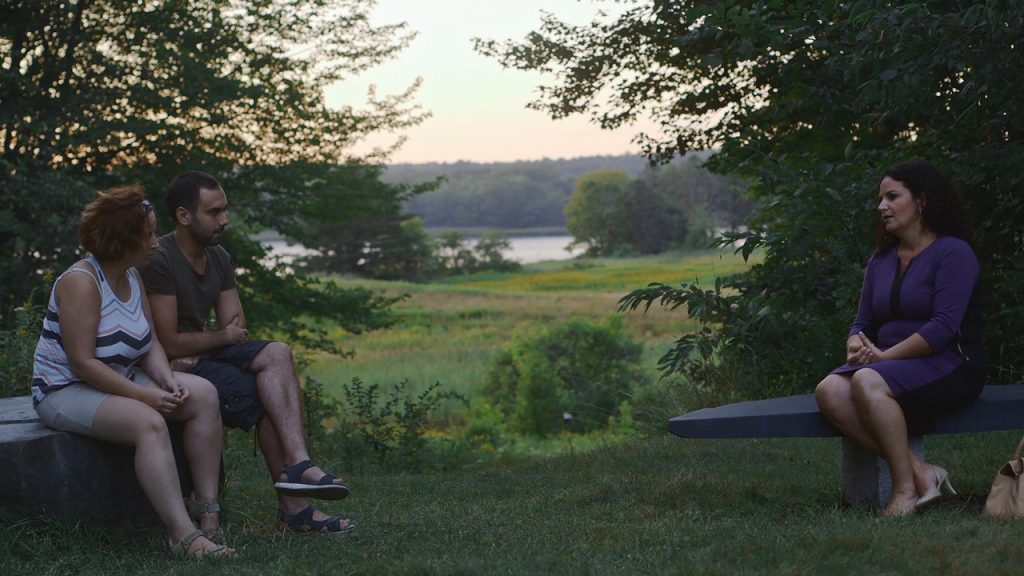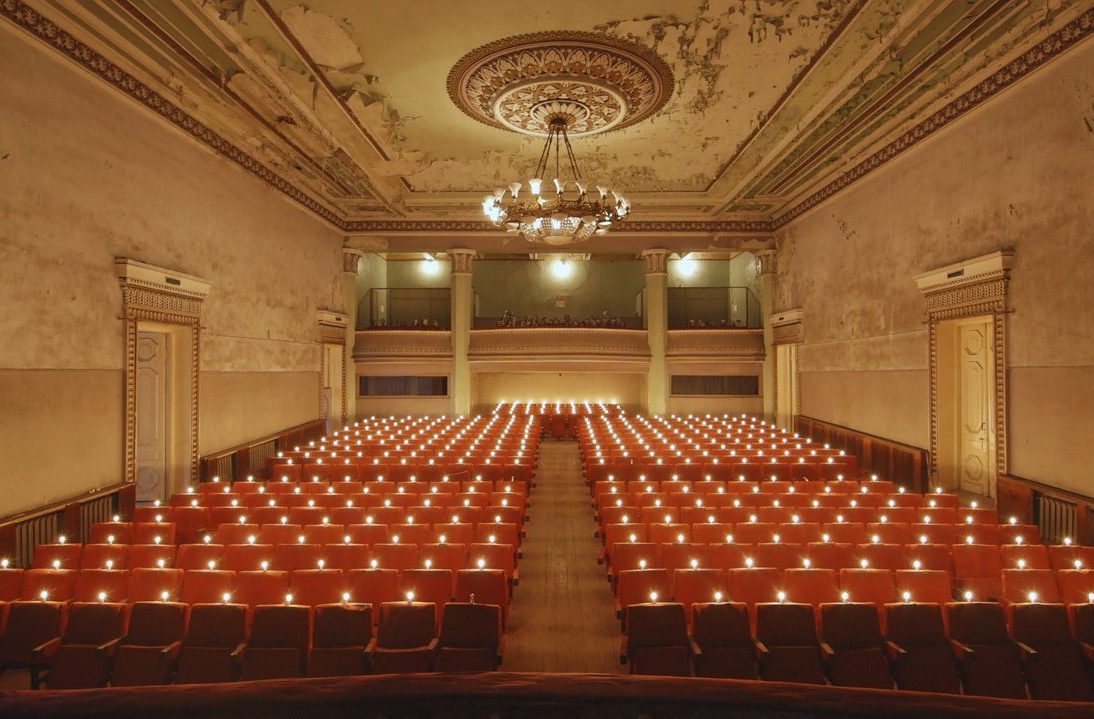Stepanakert Soviet theatre in ruins as featured in “Under the Same Sun”. Photo courtesy of Francois Jacob.
The Documentary About Nagorno Karabakh Conflict “Under The Same Sun” Currently Streaming From Canadian Hot Docs Festival Online
By Karin Saghdejian
French-Canadian filmmaker Francois Jacob’s documentary on Nagorno Karabakh conflict, “Under the Same Sun”, that premiered at Hot Docs Film Festival on May 28 (available online till June 24), explores the Nagorno Karabakh conflict through the eyes of various individuals, including Armenian American author and city councilmember Anna Astvatsaturian Turcotte as a refugee from Baku and an advocate for Artsakh.
The filmmaker and his team travel to the United States, Armenia, Artsakh, Russia and Azerbaijan in an attempt to gather different experiences and viewpoints regarding the Nagorno Karabakh war.
I reached out to Francois Jacob and Anna Astvatsaturian Turcotte to learn more about the genesis and the making of the film.
Below are my email interviews with them:
Karin Saghdejian-Nowadays, the Nagorno Karabakh conflict is considered a “frozen conflict” and has fallen off the international radar. How did you come up with the idea of making a documentary on the NK conflict?
Francois Jacob- I shot my previous film (A Moon of Nickel and Ice) in Norilsk (arctic Russia), and had learned Russian in the process. I also met several people from the Caucasus there. So, when journalist friends of mine who specialize in Oil and Gas industries asked me to join them on a trip to explore the new energy hub of Kazakhstan and Azerbaijan, I welcomed the opportunity to extend my interest in the former Soviet Union. However, while researching the region, we discovered what had happened to the Azerbaijani writer Akram Aylisli, and slowly but surely, we became very interested in the elephant in the room: the Armenian-Azerbaijani conflict. We felt that the separation of people so close during the USSR and the ongoing resent between these two people was of universal interest.
KS- While watching the documentary I realized you don’t provide any historical background as to what the fighting is all about and why did it break out in 1988? Why is that?
FJ- We do, but on a minimal level. In any case, there are several reasons for that. First and foremost, this film is not an informational historical film. If you are looking for facts from both sides and a chronology, the recently released joint project “Parts of a Circle” might slightly satisfy you more. Our project is much more about the current emotions and thoughts in the region roughly 30 years after the war rather than the factual (and lengthy) explanations of how it all started. Had we ventured down that path, we might have done a 3-hour film on the 1988-1991 period alone, loaded with experts and controversial statements about the events. Our privilege as foreigners was to be able to work on both sides of the barbed wire and listen to what people had to say today, not re-write the history of these people for a Western audience. Secondly, most of the events of 1988 leading to 1991 are seen in diametrically opposite ways in Armenia and Azerbaijan, and any historical discussion of these events would rekindle war time arguments. Most of the regional viewers already know these arguments, albeit possibly in the light of their own country’s perspective. Nevertheless, we did interview a lot of politicians, veterans and experts, and our first edits of the film ran for about 2 hours and 45 minutes. However, when we discovered that by removing these interviews from our structure, the core matter was actually clearer for the audience and the understanding of the conflict was not diminished, we felt that we had found a surprisingly deeper film.
KS-The documentary proceeds without any voice-over or a narrator giving context; it lets the pictures and scenes narrate themselves. Any reason you chose this format?
FJ- As you mentioned, the scenes speak for themselves. As a foreigner to the South Caucasus, I feel that explaining to Westerners the story with a narration of mine would be inappropriate, in the same way that commenting, fact-checking or introducing what we see would not be respectful or even necessary. This film is not the story of our team discovering the region, it is a depiction of how people of the region feel this situation themselves. I believe letting the people speak and intervening as little as possible is more authentic and respectful. Of course, we have the privilege of editing the footage and choosing what matters most in the end, but I believe we have accomplished that process with the same mindset.
KS- How long did it take to shoot the film and did you encounter any major difficulties during the filming or later in the production process?
FJ- We started shooting in February of 2017 in Baku and concluded in the summer of 2019 in Armenia. The final film was outputted in late February of 2020. Including research phases, we have travelled the South Caucasus five times, on top of the 4 different trips we made to the USA for the film. We had approximately 120 days of shooting with the crew, and over 200 hours of footage, which is enormous, considering that the final film is only 97 minutes long. Our project involved a lot of exploration, research and reading between shoots.
The main difficulties we faced in Azerbaijan were linked to the authoritarian regime: we were not free to film wherever we wanted, and could not access the border towns across the line of contact from where we filmed on the Armenian side, which was frustrating. Also, very few people would take the risk of talking to us – and I am extremely thankful to those who did. I would also say that on both sides, trust was not easily earned. We told people that our project was being done both in Azerbaijan and in Armenia, and in a lot of situations it created an uncomfortable backdrop to our conversations: people would withhold information or be suspicious of us being spies. We did believe however that it was more truthful to disclose the full extent of our project. In the rare instances that we didn’t, people spoke their minds more openly.
KS- Azerbaijan blacklists anyone who enters Karabakh. How did you overcome that hurdle?
FJ- Indeed, Azerbaijan sometimes opts to blacklist people who enter Nagorny Karabakh without official permission. We haven’t been notified of anything up until now.
KS- The film has many symbolic scenes. In the last scene, a theatre hall gets illuminated gradually while an Azeri writer cites a biblical verse. What was your main intention to wrap it up with that scene?
FJ- That theatre hall is the former Stepanakert Soviet theatre in Nagorny Karabakh. One of the other victims of war is culture, and I thought it was interesting to show a still ruined theatre in an otherwise entirely rebuilt city. Also, Akram Aylisli’s words come from another world, that of a fragile shared identity: that theatre would showcase plays in Armenian and in Azerbaijani. Those days are obviously long gone, but I thought the setting was appropriate for what I would call a «gloomily optimistic» finale. I would also like to take the opportunity here to honor a writer whose work we were unfortunately not able to include in the film: Levon Djavakhian. He has often been compared to Akram Aylisli for his humanistic approach. And I would conclude by hoping that the Aylislis and Djavakhians of tomorrow will receive a more attentive ear in the future than they do today.

Armenian and Azerbaijani protagonists debate the Karabakh conflict. Still from “Under the Same Sun”. Courtesy of Francois Jacob.
Karin Saghdejian-How did you get involved in becoming a part of the documentary?
Anna Astvatsaturian Turcotte- The director and producer François Jacob contacted me via my official Facebook Page. He told me he just finished reading my book “Nowhere, A Story of Exile” and was quite taken with my story and the story of Nagorno-Karabakh conflict in general. He told me he was in the process of making a documentary film on the conflict and thought my story of fleeing from Baku as an Armenian refugee and the work that I do for the people of Artsakh would be emblematic for the Armenian side of the story. He wanted to balance it off with the Azerbaijani side as well. At first I said “no way.” Right before this exchange I had a very negative experience with a disorganized and disappointing documentary production of a film on Artsakh conflict and I wasn’t going to go through that mess again. But he was convincing. He and his co-writer Antoine Dion-Ortega drove from Montreal to my home in Maine and we spoke about their concept all afternoon. They showed me footage of what they’ve already filmed in Baku with Azerbaijani writer Alram Aylisli. In our first meeting and the follow up interactions I learned that he was an intellectually curious film maker and he was an artist. His imagery was beautiful, he asked the right questions, and he was emotionally invested. While working on his last film in Russia, Francois became fluent in Russian. By the next time we met in person he spoke in Armenian, which was quite telling of the level of research he does on each subject matter he covers. After that first meeting, I immediately did a thorough due diligence to ensure that this was not some sort of a provocation by Azerbaijan and thankfully Francois turned out to not be an Azerbaijani agent. And hence I agreed to take part in the film.
KS- In the film you walk through quite an emotional journey. What prompted you to relay your story?
AAT- I spent the last eight years of my life advocating for Artsakh since coming out publicly about my childhood through my book and story of the sacrifices my community of 350,000 Armenians from Azerbaijan had to make to survive: many were killed, raped, all were robbed and exiled in response to Artsakh’s independence movement. I do this painful and haunting walk through the memory lane over and over again to demonstrate and educate about the amount of pain the Armenian community of Azerbaijan endured and the type of horror Artsakh will see if ever under Azerbaijani control. This was another venue to educate. And this was another way to give back to honor the Armenian history. This is another way to honor my killed neighbors and demolished graves of my grandparents in Baku.
KS-Do you feel you were able to reveal your truth, as a refugee who has fled Baku, and as a human rights advocate who believes in the self determination of Artsakh, while sharing your experiences?
AAT- I do and I don’t. I’m proud and stand by every word that I said, especially when speaking about Artsakh and their plight and resilience. François gave me an opportunity to speak and tell my story and through me I was able to speak about the violence against Armenian civilians of Sumgait, Kirovabad, Baku and now Artsakh. And I tell my truth, regardless of the audience. But many things weren’t included in the film. And that is one of the reasons I don’t endorse it. The most poignant moment to me in the filming was the 200+ Baku refugees that gathered to hear me speak for the 30th anniversary of Sumgait pogroms. The event was held in St John Garabed Armenian Church in San Diego, California and the organizers said they’ve never seen the Baku Armenian community come out to any event in such numbers. There is a photo of all of us together and it was just the women, men decided not to be in the photo, and the amount of people in such pain in one photo was overwhelming to me. My speeches always bring 2-3 people who want to share their story with me. But this was different. After my speech so so many people came up to me and told me stories about their killed family members or the details of their escape from Azerbaijan, many for the first time. They were so proud that someone was actually speaking on their behalf when the diaspora at large ignored and forgot them. They were so broken still 30 years later because of the trauma they endured at the hands of Azerbaijani government. After the event when I was alone, I sobbed myself to sleep. It was that powerful. And François chose not to include this scene. That was disappointing. Whether for the lack of time or the lack of balance of the same amount of information from the Azerbaijani side, I don’t know why. But my pain, my story is minuscule compared to the violence and trauma endured by so many refugees. There is no comparisons on the other side. That’s why I think it was cut. And that imbalance in the scene alone would have been enough to tell our story.
You can watch the documentary online:
Francois Jacob’s previous films include: “A Moon of Nickel and Ice” (2017), “La queue du train” (2008), “Tu la suivras” (2014).
Anna Astvatsaturian Turcotte is the author of “Nowhere, a Story of Exile”.

